SARA
A BRIEF PORTRAIT
When Sara became pregnant in 1963, she chose a
procedure called conscious cooperative childbirth. The procedure was given this
somewhat unwieldy name partly to distinguish it from natural childbirth. With
conscious cooperative childbirth, the mother would normally go through the whole
process without using anesthetics. Anesthetics would be available if necessary
and she would keep them to a minimum if she had to use them.
That sounds very
uncontroversial today. It’s become pretty much the standard way to have
children. Both our grandchildren came into the world via a modern version of
conscious, cooperative childbirth, in special birthing rooms where all the
standby equipment was hidden behind wooden paneling, and the procedure had the
complete support of a female obstetrician.
They received the advantages
of this kind of birth because of the pioneering efforts of women like their
grandmother. In 1964, the medical profession viewed the whole idea with
suspicion, and even downright hostility. When I attended one of the classes
Sara was taking, I heard one women talk about her experience with a doctor who
had assured her he agreed to the idea. When she was rolled into the delivery room, a nurse gave
her a shot, and she woke up two hours later and discovered she had become a
mother while she was unconscious.
Sara was the second woman to
have her child by this method at Presbyterian Hospital in West Philadelphia.
The first woman had been Sara’s friend Laura Burdelson Kennedy, who had been
Sara’s classmate at McCormick Seminary. Thanks to them, I got to be the second
father to be present in the delivery room. I got to experience that wonderful
moment when we both, at the same instant, saw our son for the first time. I also
acquired a lifelong respect for the gallantry of the childbearing half of the
human species.
I didn’t know Sara was going to do this until she
took me to one of her classes. It was her idea. I had nothing to do
with her decision. Even if I had thought about it myself, I couldn’t have
asked her to do it, since I obviously couldn’t try it out and let her know I
thought she could handle it.
Sara went through pregnancy
a year or two after the thalidomide disaster. Pregnant women had been given a
new tranquilizer called thalidomide and the women who had used it during a
certain part of their pregnancy had produced badly deformed children. I had
read an article on the thalidomide episode in Scientific American and the
author had concluded that pregnant women shouldn’t take anything they didn’t
need to take. Sara even gave up drinking wine while she was pregnant.
This was also a time when we
were concerned about the fallout from nuclear testing and the effects it might
have on growing children and unborn children.
I naturally assumed
thalidomide had been one of the main reasons Sara had made this choice.
Thalidomide certainly played a part in her thinking. But
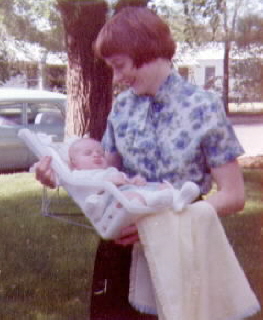 years
later-- many years later-- I learned there had been more to it than that.
When Sara had been born in 1930, her mother had had her without anesthetics.
Her mother had done this, furthermore, at a time when there had been no support
groups or classes like the sessions Sara and Laura had attended-- a time when
anesthetics and painless childbirth were still new enough that Sara's mother probably looked like a luddite. Winnie Mae Wescoat had reasoned that anything that knocked her out had
to be a kind of poison, and anything that affected her, would probably affect
her child. She had therefore concluded that it was her duty to have her child
without anesthetics if she could. Thirty-three years later, Sara had felt she
should do for her child what her mother had done for her.
years
later-- many years later-- I learned there had been more to it than that.
When Sara had been born in 1930, her mother had had her without anesthetics.
Her mother had done this, furthermore, at a time when there had been no support
groups or classes like the sessions Sara and Laura had attended-- a time when
anesthetics and painless childbirth were still new enough that Sara's mother probably looked like a luddite. Winnie Mae Wescoat had reasoned that anything that knocked her out had
to be a kind of poison, and anything that affected her, would probably affect
her child. She had therefore concluded that it was her duty to have her child
without anesthetics if she could. Thirty-three years later, Sara had felt she
should do for her child what her mother had done for her.
Sara had a rigorous
theology, which she had largely acquired, I assume, at McCormick. It was a
theology I always respected, even if I didn’t share some of its assumptions.
One of the best examples of that theology was a sermon she was asked to give
when one of our friends died many years ago. She concluded by saying that she
did not know what happened to us after death. But it was her faith, that
whatever God had planned for us was the right thing for us.
Sara Wescoat was born on
August 18, 1930, in Amarillo, Texas. Amarillo is located in the center of the
panhandle, which is the part of Texas that sticks up into the Midwest, just west
of Missouri. It probably had a population of around 100,000 when she
was born, which meant it was the metropolis, the big city, of the panhandle.
She liked to quote Carl Sandburg who said the only thing between Amarillo and
the North Pole was a single strand of barbed wire. Her grandmother, on her
mother’s side, had been one of the last women to cross the prairie in a covered
wagon. Her grandfather had driven cattle up one of the famous trails, like the
Chisholm Trail. There were still towns in the panhandle, when she was a child,
that held parties to celebrate their twenty-first birthday.
She was the only child of
Winnie Mae and Curtis Wescoat. Her father, as far as I can tell, spent most of
his working life as a bookkeeper in a lumberyard. The Great Depression spanned
most of her childhood, so she had a somewhat frugal upbringing. But she had
dolls, which didn’t mean much to her, and books,
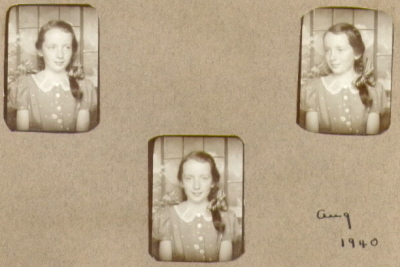 which did, and a bicycle. She
could remember big extended-family holiday dinners where there were so many
people the children sat at separate tables and you worked your way up, table by
table, over the years, to the adult table. She had five cousins in the service
during World War Two and she read the war news primarily so she could see how
much danger they were in. In high school, she was a member of the Honor Society
and the debating team, which seems to have been a popular competitive activity
in that area of the country. She sometimes said she might have been a lawyer,
if she had been born later. But in those days, in that area, women did not
normally become lawyers. She attended Amarillo Junior College for two years and
graduated phi beta kappa from Denver University.
which did, and a bicycle. She
could remember big extended-family holiday dinners where there were so many
people the children sat at separate tables and you worked your way up, table by
table, over the years, to the adult table. She had five cousins in the service
during World War Two and she read the war news primarily so she could see how
much danger they were in. In high school, she was a member of the Honor Society
and the debating team, which seems to have been a popular competitive activity
in that area of the country. She sometimes said she might have been a lawyer,
if she had been born later. But in those days, in that area, women did not
normally become lawyers. She attended Amarillo Junior College for two years and
graduated phi beta kappa from Denver University.
In her later years, she
usually
shrugged off her phi
beta kappa honors on the grounds that she had taken a lot of creative writing
courses. Her work at Denver had also included some serious religion
courses, however. Somewhere along the line,
she had decided to go into church work. Her mother felt that was an insecure
occupation, so, to soothe her mother’s fears, she taught sixth grade in a school
outside Denver for a year and acquired her teaching credentials. Then she went
off to McCormick Theological Seminary in Chicago, one of the leading Protestant
seminaries in the United States, where
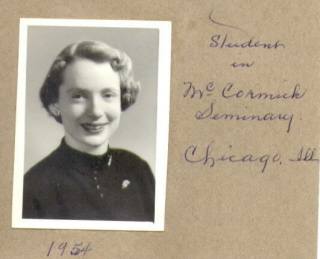 she studied with people like Hulda
Niehbur, the sister of the great Protestant theologians Reinhold and Richard
Niehbur, and acquired a thorough background in theology, church history, and
similar subjects.
she studied with people like Hulda
Niehbur, the sister of the great Protestant theologians Reinhold and Richard
Niehbur, and acquired a thorough background in theology, church history, and
similar subjects.
In those days, the men
normally became Presbyterian ministers and the women became Directors of
Christian Education, which meant that they ran the Sunday school programs in the
local churches. Sara became the DCE at the Presbyterian Church in Pampa, Texas,
in the panhandle.
The Presbyterians took their
Sunday school programs very seriously, which surprised me when I met Sara.
The Sunday schools I had attended had been much more casual. The
curriculum for the Sunday schools was created in Philadelphia, at the
Presbyterian Board of Christian Education, which was located in the Witherspoon
Building, at Juniper and Walnut, in center city. If you go by the
Witherspoon Building today, you can still
see the inscriptions that advertise its original purpose. The curriculum was issued to the churches in a group
of quarterly magazines, one for each age
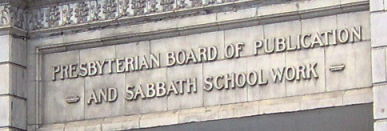 group, which contained the lesson plans
for the quarter. Each lesson plan contained a 500 word essay on the lesson, and
then the lesson plan proper. Sara started writing lesson plans freelance for
the Board while she was in Pampa. They liked her work so much that, after about
a year, when one of the editors resigned to get married, they asked Sara to come
to Philadelphia and she became the youngest editor on the Board.
group, which contained the lesson plans
for the quarter. Each lesson plan contained a 500 word essay on the lesson, and
then the lesson plan proper. Sara started writing lesson plans freelance for
the Board while she was in Pampa. They liked her work so much that, after about
a year, when one of the editors resigned to get married, they asked Sara to come
to Philadelphia and she became the youngest editor on the Board.
She had planned to resign
after five years and return to Texas. She felt you couldn’t work more than
five years at a job like that without getting stale. She did resign on
schedule in 1962, but she resigned to stay in Philadelphia and become a mother.
For the next five years, she freelanced extensively for the Board, so much she
was essentially holding down a part time job at home.
When she reentered the labor
force when Christopher started school, the Presbyterians were leaving the city,
because of a series of denominational mergers. She took a job at
Presbyterian Hospital and started a new career as a
development writer and development officer. She became part of that army of
people who produce the fund raising letters, fund raising brochures, and fund
raising speeches and grant proposals, that keep our charitable and cultural
institutions functioning. She was a development writer and director of annual
giving at Presbyterian Hospital for twelve years. She filled similar posts
for four years at the University of
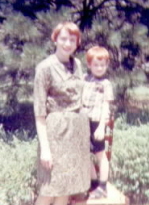 Pennsylvania Dental School, and for eight
years at Episcopal Community Services, which is the charitable arm of the
Episcopal Church in Philadelphia.
Pennsylvania Dental School, and for eight
years at Episcopal Community Services, which is the charitable arm of the
Episcopal Church in Philadelphia.
She was a working woman all
her life, but when somebody once asked her what her ambition had been when she
had been a child, she surprised them by saying her main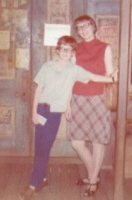 ambition had been to be
a wife and mother. She always said she had been glad she had stopped working
full time when Christopher was a preschooler, because she would have hated to
have missed seeing this little baby develop into a person. I probably should
add, however, that while she liked being a wife and mother, she was not very
interested in staying home and doing housework. And it would have been a waste
if she had.
ambition had been to be
a wife and mother. She always said she had been glad she had stopped working
full time when Christopher was a preschooler, because she would have hated to
have missed seeing this little baby develop into a person. I probably should
add, however, that while she liked being a wife and mother, she was not very
interested in staying home and doing housework. And it would have been a waste
if she had.
During one of the last times
we went to a concert together, I found myself thinking I had been very lucky to
have a wife who was happy to go to all the concerts a diligent music critic is
supposed to attend. But then it occurred to me I might have found another
woman who was willing to take in two or three-- or sometimes five or six--
musical events per week in the season. But would that same woman have been
willing to go to the meetings of the Philadelphia Science Fiction Society, and
the annual Philadelphia Science Fiction Conference, and the various events
conducted by Science Fiction Writers of America? And if she had been
willing to do both of those things, would she have been willing to hang around
with the bicycle people when we were bicycling, and the karate people when
Christopher was studying karate, and all the other kinds of people you meet in a
big city, including, of course, the coffee house people, who gave us many of the
friends we enjoyed for most of our marriage?
As I mentioned in the second
chapter of the memoir I’m publishing on this website, Sara and I met, in
November, 1957, at the Gilded Cage coffeehouse, which was located in center city
near Rittenhouse Square. As I have often told people, the guests at our
wedding, when we were married at Old Pine Church in November, 1960, mostly came
from three groups: Sara’s colleagues at the Presbyterian Board of Christian
Education, members of the Philadelphia Science Fiction Society, and habitues of
the Gilded Cage coffeehouse.
My collection of Sara
pictures includes two pictures of Sara at her ordination as a Director of
Christian Education in Pampa and this picture, one of my f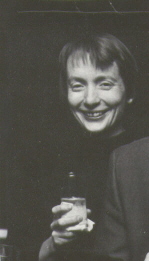 avorites,
which shows Sara smiling over a beer bottle at a Science Fiction Writers of America
banquet in New York around 1970.
avorites,
which shows Sara smiling over a beer bottle at a Science Fiction Writers of America
banquet in New York around 1970.
She liked cities--
Philadelphia in particular, and cities in general. We both discovered we were
city people about the time we met but it was probably a bigger transformation
for Sara. When she was living in her native land, she thought it was perfectly
reasonable to get in her car and drive two blocks to go to lunch. When she came
to Philadelphia, she saw where she and her roommate would be living, in a three
story rowhouse in the heart of center city, and did something that would be
unthinkable in her home culture. She gave up her car. She not only left it in
Texas, she sold it to her father.
I was still in the Army when
we got married, and I took a three week leave. We both agreed we would spend a
big part of our honeymoon in New Hope in Bucks County, which we both liked, and finish up in New
York. After three days in New Hope, however, which we liked, we decided
we'd had all the rural living we needed and we got on a bus to
New York, took a room in a cheap hotel on Times Square, and spent most of our
honeymoon going to plays and movies, visiting places like the Guggenheim and the
Cloisters, and eating in New York restaurants and Times Square cafeterias.
We spent our honeymoon, in other words, in the same way we spent much of the rest of our married
life.
When Sara resigned from the
Board, her successor came a couple of months early, so she could help him get
acclimated. One night we took him and his wife to one of the best known
restaurants of the era, which was located in the Lebanese
neighborhood a few blocks below center city. The senior member of the
family that owned the restaurant started chatting with us when we were paying
our bill. When he learned we were going to the Gilded Cage, he told us to
wait a minute and came back to the counter lugging a huge salad for us to transport
across town to Esther Halpern, who ran the Gilded Cage with her husband Ed. Sara received a package of
apricot candy as a carrying fee.
Sara liked to tell people
about the incident and she always noted that our guests had been wide-eyed.
She felt it was a good example of
the way people think cities are cold and impersonal, when they’re really
crisscrossed with personal relationships.
She had a noticeable
capacity for whimsy and playfulness. We had a professional soccer team in
Philadelphia in the 70s and a bunch of us used to go to all the home games.
When it came time to boo the referee, or some member of the opposition who had
done something particularly dastardly, we all agreed Sara was our best booer.
She was five years older
than me, and we once got to thinking about the fact that I was five when she was ten, and
ended up playing with the idea that I had started receiving
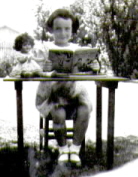 mysterious letters from a bossy
little girl in Texas. The next time I had a birthday, my presents included a
package with several of those letters, properly dated, and written in age
appropriate styles, saying things like “Make sure you eat your spinach, little
boy, so you’ll grow up to be a nice healthy husband.”
mysterious letters from a bossy
little girl in Texas. The next time I had a birthday, my presents included a
package with several of those letters, properly dated, and written in age
appropriate styles, saying things like “Make sure you eat your spinach, little
boy, so you’ll grow up to be a nice healthy husband.”
She liked children’s
literature. We lived near the main library up until Christopher was about
three and Sara and Christopher would visit the big children’s section
about twice a week, and come home with stacks of children’s books for her to
read to him. Curious George, Horton the Elephant, Little Bear, and all
the rest of them, became a permanent part of our family traditions.
One of the great
disappointments of her life was the six weeks she spent as an editor at Jack
and Jill, just after she returned to fulltime work. That was
practically her dream job-- being an editor of a national children’s magazine
with some hope she might someday become The editor. Then, after six weeks, they told her
they were moving the operation to Indianapolis. They would have taken her with
them, but we decided that, on the whole, we would rather be in Philadelphia.
Her favorite children’s
character was Mary Poppins-- the real Mary Poppins, the one
depicted in the books. When she was working at Presbyterian Hospital, the first
thing she told me when she came home one day, was that she had been riding her
bicycle across the Penn campus, on the way to work, and heard someone
say, “Look, Mary Poppins!”
She liked outspoken,
assertive women like Mary Poppins and the kind of women Katharine Hepburn played
in the movies, but she was, herself, the kind of person who avoided
confrontations. When I became somewhat overheated during a political
discussion when we were first married, she was the person who reminded me
afterward that there was no point in winning an argument if you lost a friend.
I think she was a lot
tougher than she thought she was. At critical points in her life, she made some
very unconventional decisions-- decisions that were based on her desire to live
her life the way she wanted to live it or thought she should live it.
She married me, even though
her parents and many of her oldest friends couldn’t imagine how she could
possibly make such a choice. She chose to live in the city when most people her
age were heading for the suburbs. And she chose to have her child the way she
thought she should, even though it was such an odd choice at that time that the
nurses at Presbyterian Hospital kept popping into the labor room to see the woman who was
doing this strange thing.
Her grandmother had gone
west, to take up the opportunities and challenges of a new country. Sara left
that country, which had become somewhat tame, and went the other way, to take up
the opportunities and challenges of an American city in the second half of the
twentieth century.
When I was a teenager, I
used to think about the kind of woman I wanted to marry, and the kind of
marriage I wanted to have, and I created a kind of outline in my head. Sara
fitted that outline about as well as any individualistic, multi-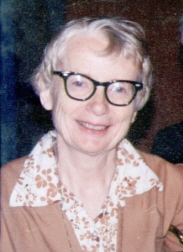 faceted human
could. I think the essence of that vision could be summarized in two bits of
poetry. Over the years I put both of them on valentines and birthday cards I
made for her. One of them is very familiar-- Let me not to the marriage of
true minds admit impediments. The other is less famous. It’s four lines
from a poem called The Ballad of William Sycamore by Stephen Vincent
Benet. The Ballad of William Sycamore tells the story of a man who grew
up in the bloody ground of Kentucky, went westward with the great migration, and
did all the things the pioneers did. In the middle of the poem, there’s this
verse:
faceted human
could. I think the essence of that vision could be summarized in two bits of
poetry. Over the years I put both of them on valentines and birthday cards I
made for her. One of them is very familiar-- Let me not to the marriage of
true minds admit impediments. The other is less famous. It’s four lines
from a poem called The Ballad of William Sycamore by Stephen Vincent
Benet. The Ballad of William Sycamore tells the story of a man who grew
up in the bloody ground of Kentucky, went westward with the great migration, and
did all the things the pioneers did. In the middle of the poem, there’s this
verse:
I lost my boyhood and found my wife,
A girl like a Salem Clipper.
A woman straight as a hunting knife.
With eyes as bright as the dipper.
Home | Science Fiction |
Music Writing | Essays
Bio | FAQS |
Writers | Friends and Relations |
Quotes | Bibliography
 years
later-- many years later-- I learned there had been more to it than that.
When Sara had been born in 1930, her mother had had her without anesthetics.
Her mother had done this, furthermore, at a time when there had been no support
groups or classes like the sessions Sara and Laura had attended-- a time when
anesthetics and painless childbirth were still new enough that Sara's mother probably looked like a luddite. Winnie Mae Wescoat had reasoned that anything that knocked her out had
to be a kind of poison, and anything that affected her, would probably affect
her child. She had therefore concluded that it was her duty to have her child
without anesthetics if she could. Thirty-three years later, Sara had felt she
should do for her child what her mother had done for her.
years
later-- many years later-- I learned there had been more to it than that.
When Sara had been born in 1930, her mother had had her without anesthetics.
Her mother had done this, furthermore, at a time when there had been no support
groups or classes like the sessions Sara and Laura had attended-- a time when
anesthetics and painless childbirth were still new enough that Sara's mother probably looked like a luddite. Winnie Mae Wescoat had reasoned that anything that knocked her out had
to be a kind of poison, and anything that affected her, would probably affect
her child. She had therefore concluded that it was her duty to have her child
without anesthetics if she could. Thirty-three years later, Sara had felt she
should do for her child what her mother had done for her. which did, and a bicycle. She
could remember big extended-family holiday dinners where there were so many
people the children sat at separate tables and you worked your way up, table by
table, over the years, to the adult table. She had five cousins in the service
during World War Two and she read the war news primarily so she could see how
much danger they were in. In high school, she was a member of the Honor Society
and the debating team, which seems to have been a popular competitive activity
in that area of the country. She sometimes said she might have been a lawyer,
if she had been born later. But in those days, in that area, women did not
normally become lawyers. She attended Amarillo Junior College for two years and
graduated phi beta kappa from Denver University.
which did, and a bicycle. She
could remember big extended-family holiday dinners where there were so many
people the children sat at separate tables and you worked your way up, table by
table, over the years, to the adult table. She had five cousins in the service
during World War Two and she read the war news primarily so she could see how
much danger they were in. In high school, she was a member of the Honor Society
and the debating team, which seems to have been a popular competitive activity
in that area of the country. She sometimes said she might have been a lawyer,
if she had been born later. But in those days, in that area, women did not
normally become lawyers. She attended Amarillo Junior College for two years and
graduated phi beta kappa from Denver University. she studied with people like Hulda
Niehbur, the sister of the great Protestant theologians Reinhold and Richard
Niehbur, and acquired a thorough background in theology, church history, and
similar subjects.
she studied with people like Hulda
Niehbur, the sister of the great Protestant theologians Reinhold and Richard
Niehbur, and acquired a thorough background in theology, church history, and
similar subjects. group, which contained the lesson plans
for the quarter. Each lesson plan contained a 500 word essay on the lesson, and
then the lesson plan proper. Sara started writing lesson plans freelance for
the Board while she was in Pampa. They liked her work so much that, after about
a year, when one of the editors resigned to get married, they asked Sara to come
to Philadelphia and she became the youngest editor on the Board.
group, which contained the lesson plans
for the quarter. Each lesson plan contained a 500 word essay on the lesson, and
then the lesson plan proper. Sara started writing lesson plans freelance for
the Board while she was in Pampa. They liked her work so much that, after about
a year, when one of the editors resigned to get married, they asked Sara to come
to Philadelphia and she became the youngest editor on the Board. Pennsylvania Dental School, and for eight
years at Episcopal Community Services, which is the charitable arm of the
Episcopal Church in Philadelphia.
Pennsylvania Dental School, and for eight
years at Episcopal Community Services, which is the charitable arm of the
Episcopal Church in Philadelphia. ambition had been to be
a wife and mother. She always said she had been glad she had stopped working
full time when Christopher was a preschooler, because she would have hated to
have missed seeing this little baby develop into a person. I probably should
add, however, that while she liked being a wife and mother, she was not very
interested in staying home and doing housework. And it would have been a waste
if she had.
ambition had been to be
a wife and mother. She always said she had been glad she had stopped working
full time when Christopher was a preschooler, because she would have hated to
have missed seeing this little baby develop into a person. I probably should
add, however, that while she liked being a wife and mother, she was not very
interested in staying home and doing housework. And it would have been a waste
if she had. avorites,
which shows Sara smiling over a beer bottle at a Science Fiction Writers of America
banquet in New York around 1970.
avorites,
which shows Sara smiling over a beer bottle at a Science Fiction Writers of America
banquet in New York around 1970. mysterious letters from a bossy
little girl in Texas. The next time I had a birthday, my presents included a
package with several of those letters, properly dated, and written in age
appropriate styles, saying things like “Make sure you eat your spinach, little
boy, so you’ll grow up to be a nice healthy husband.”
mysterious letters from a bossy
little girl in Texas. The next time I had a birthday, my presents included a
package with several of those letters, properly dated, and written in age
appropriate styles, saying things like “Make sure you eat your spinach, little
boy, so you’ll grow up to be a nice healthy husband.” faceted human
could. I think the essence of that vision could be summarized in two bits of
poetry. Over the years I put both of them on valentines and birthday cards I
made for her. One of them is very familiar-- Let me not to the marriage of
true minds admit impediments. The other is less famous. It’s four lines
from a poem called The Ballad of William Sycamore by Stephen Vincent
Benet. The Ballad of William Sycamore tells the story of a man who grew
up in the bloody ground of Kentucky, went westward with the great migration, and
did all the things the pioneers did. In the middle of the poem, there’s this
verse:
faceted human
could. I think the essence of that vision could be summarized in two bits of
poetry. Over the years I put both of them on valentines and birthday cards I
made for her. One of them is very familiar-- Let me not to the marriage of
true minds admit impediments. The other is less famous. It’s four lines
from a poem called The Ballad of William Sycamore by Stephen Vincent
Benet. The Ballad of William Sycamore tells the story of a man who grew
up in the bloody ground of Kentucky, went westward with the great migration, and
did all the things the pioneers did. In the middle of the poem, there’s this
verse: